3 Steps to Cultivate an Innovation Culture
Organizational Talent Consulting
JULY 24, 2023
The proven benefits of innovation include: increased competitive advantage improved operational productivity reduced costs and increased revenue improved commercial value enhanced problem-solving One modern innovation that is impressive to watch is SpaceX's reusable Falcon 9 (watch the video below). References: Beswick, C., Bishop, D., &











Let's personalize your content